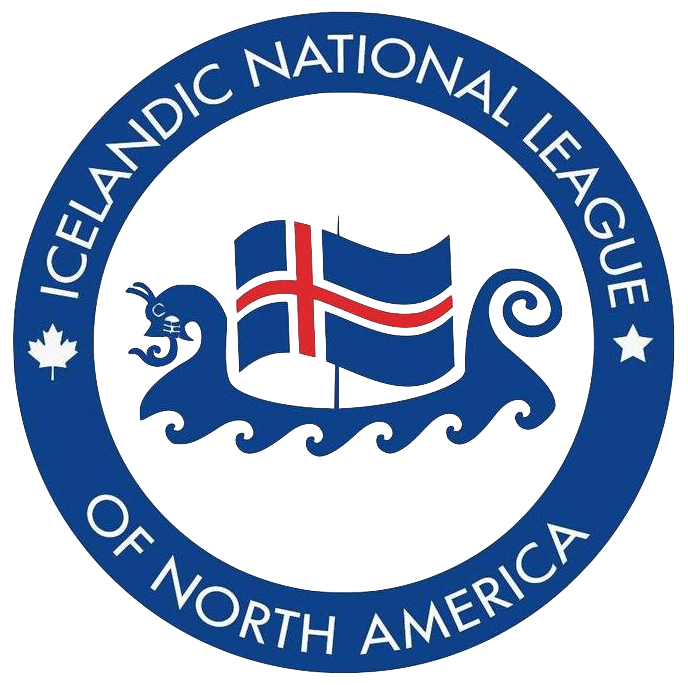Coat of Arms
The Icelandic National League Coat of Arms
Granted by the Canadian Heraldic Authority
Ottawa, January 1, 2000
The Shield - which is blue in colour. bears a white falcon, a very old, nonpolitical symbol of Iceland which was used for centuries and is said to have been granted to Loftur Guttormsson 'the Rich' (1375-1432), an Icelandic knight from whom all contemporary people of Icelandic descent are descended. The white falcon was the symbol of choice used by the Icelanders who first came to North America and a blue banner displaying the white falcon was paraded through the streets of Milwaukee by Icelanders celebrating the millennium of Iceland's settlement in 1874. Iceland did not have its current flag at the time our ancestors emigrated, and the flag is thus more symbolic of modern Iceland. On the breast of the falcon is an open book, symbolic of our literary heritage which includes the sagas and a rich tradition of poetry, history, genealogy, and literacy. Framing the shield is a white border with a red band, which at each of the three corners forms a maple leaf.
The Helm - or armorial helmet displayed above the shield is a standard traditional heraldic device.
The Mantling - is the decorative display of ribbons descending from the helm. This, too, is a standard heraldic device, but in this case the colours red, white, and blue have special significance.
The Crest - rising from the helm consists of a Norse longship (Iceland was settled by Norsemen, only a few on whom qualified as 'Vikings'. Norse was their race, whereas 'Viking' was an occupation not unlike that of 'Pirate'. Most Norsemen were not, in fact, 'Vikings', but rather traders, farmers, etc.) The longship displays both the Pagan dragon prow and a Christian cross, as both Pagan and Christian traditions were important aspects of our heritage. Rising from the longship is the World Ash tree, `Yggdrasil', a motif from Norse mythology, which with its roots shown in the Celtic interlacing pattern represents both the Norse and Celtic racial andcultural origins of all Icelandic people. The tree also signifies the 'family tree' and the bonds of kinship shared by all people of Icelandic descent. The green leaves also symbolize growth and renewal, at the same time suggesting the spring leaves alluded to in `Vísur Íslendinga', the famous Icelandic poem and song by Jónas Hallgrímsson once sung whenever Icelanders came together and still strongly associated with reunion and fellowship.
The Motto - displayed on the banner beneath the shield reads `Römm Er Sú Taug', meaning 'Strong Is The Bond'. This phrase was made familiar in 'New Iceland' by the poet Friðrik Sigurðsson, who chose this as the title of his anthology of poetry, and it is a fitting sentiment for our organization.
This coat of arms was developed jointly by the Icelandic National League and the Canadian Heraldic Authority over a six year period, from 1994 to 2000. A simplified line drawing has also been commissioned for small formats such as letterhead, pins, etc. Elements from the coat of arms can be used separately in appropriate situations. Written approval from the Icelandic National League must be obtained for all commercial uses and applications.




